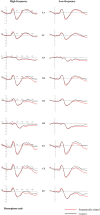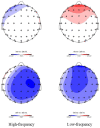An ERP Study on the Role of Phonological Processing in Reading Two-Character Compound Chinese Words of High and Low Frequency
- PMID: 33716906
- PMCID: PMC7947322
- DOI: 10.3389/fpsyg.2021.637238
An ERP Study on the Role of Phonological Processing in Reading Two-Character Compound Chinese Words of High and Low Frequency
Abstract
Unlike in English, the role of phonology in word recognition in Chinese is unclear. In this event-related potential experiment, we investigated the role of phonology in reading both high- and low-frequency two-character compound Chinese words. Participants executed semantic and homophone judgment tasks of the same precede-target pairs. Each pair of either high- or low-frequency words were either unrelated (control condition) or related semantically or phonologically (homophones). The induced P200 component was greater for low- than for high-frequency word-pairs both in semantic and phonological tasks. Homophones in the semantic judgment task and semantically-related words in the phonology task both elicited a smaller N400 than the control condition, word frequency-independently. However, for low-frequency words in the phonological judgment task, it was found that the semantically related pairs released a significantly larger P200 than the control condition. Thus, the semantic activation of both high- and low-frequency words may be no later than phonological activation.
Keywords: Chinese word recognition; N400; P200; homophonic; word frequency.
Copyright © 2021 Wang, Jiang, Huang and Qiu.
Conflict of interest statement
The authors declare that the research was conducted in the absence of any commercial or financial relationships that could be construed as a potential conflict of interest.
Figures







Similar articles
-
An ERP study on the time course of phonological and semantic activation in Chinese word recognition.Int J Psychophysiol. 2009 Sep;73(3):235-45. doi: 10.1016/j.ijpsycho.2009.04.001. Epub 2009 Apr 7. Int J Psychophysiol. 2009. PMID: 19358866
-
Interaction between Phonological and Semantic Processes in Visual Word Recognition using Electrophysiology.J Vis Exp. 2021 Jun 29;(172). doi: 10.3791/62673. J Vis Exp. 2021. PMID: 34279498
-
P200 and phonological processing in Chinese word recognition.Neurosci Lett. 2010 Mar 31;473(1):37-41. doi: 10.1016/j.neulet.2010.02.014. Epub 2010 Feb 12. Neurosci Lett. 2010. PMID: 20153807
-
ERP correlates of the development of orthographical and phonological processing during Chinese sentence reading.Brain Res. 2008 Jul 11;1219:91-102. doi: 10.1016/j.brainres.2008.04.052. Epub 2008 Apr 27. Brain Res. 2008. PMID: 18539265
-
Limited role of phonology in reading Chinese two-character compounds: evidence from an ERP study.Neuroscience. 2014 Jan 3;256:342-51. doi: 10.1016/j.neuroscience.2013.10.035. Epub 2013 Oct 25. Neuroscience. 2014. PMID: 24505608
Cited by
-
Frequency Effects on Spelling Error Recognition: An ERP Study.Front Psychol. 2022 Apr 14;13:834852. doi: 10.3389/fpsyg.2022.834852. eCollection 2022. Front Psychol. 2022. PMID: 35496180 Free PMC article.
-
The role of orthographic and phonological processing during reading Chinese sentences: Evidence from eye movements.Front Psychol. 2023 Aug 17;14:1148815. doi: 10.3389/fpsyg.2023.1148815. eCollection 2023. Front Psychol. 2023. PMID: 37663353 Free PMC article.
-
Lexical pathway from L2 to L1 activation in intermediate proficient bilinguals: behavioral and ERP evidence.Front Hum Neurosci. 2024 Jun 3;18:1270377. doi: 10.3389/fnhum.2024.1270377. eCollection 2024. Front Hum Neurosci. 2024. PMID: 38915819 Free PMC article.
-
Psychological and Electrophysiological Correlates of Word Learning Success.Psychol Russ. 2021 Jun 30;14(2):171-192. doi: 10.11621/pir2021.0111. eCollection 2021. Psychol Russ. 2021. PMID: 36810997 Free PMC article.
-
Measurement of Extraneous and Germane Cognitive Load in the Mathematics Addition Task: An Event-Related Potential Study.Brain Sci. 2022 Aug 4;12(8):1036. doi: 10.3390/brainsci12081036. Brain Sci. 2022. PMID: 36009099 Free PMC article.
References
LinkOut - more resources
Full Text Sources
Other Literature Sources

